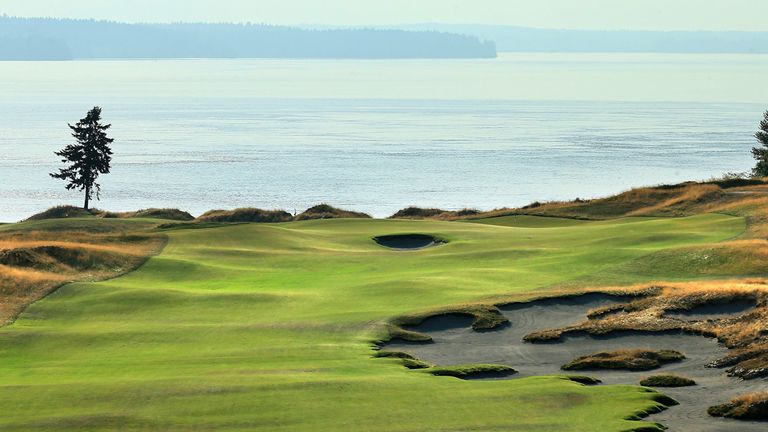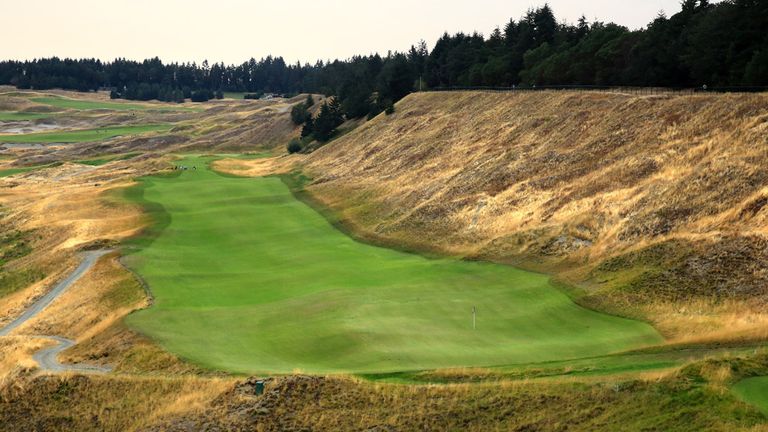US Open 2015: How to play Chambers Bay
Last Updated: 18/06/15 6:26pm
As the US Open heads to a new venue, we guide you through how to play Chambers Bay.
Hole 1, Puget Sound, 496-598 yards, par 4 or par 5
For the first time in US Open history, a hole will have a different par depending on the round. The fairway is generous off the tee and should be reachable in two depending on the wind strength. When a par 4, the landing area is much tighter so will be more of a challenge to find.
Hole 2, Foxy, 399 yards, par 4
An iron off the tee reduces the risk of finding the knob in the landing area. A short iron will be left to a green that has a slope off the right, and a large sand area left of the green.
Hole 3, Blown Out, 163-198 yards, par 3

The bunker on the left-side of the kidney shaped green is deep and dotted with deep fescue. The green features a small ridge, and with contours on the putting surface, players can get creative to try to get close to various pin positions.
Hole 4, Hazard’s Ascent, 495 yards, par 4
The safe shot is down the left, which makes the hole slightly longer. The right side requires the player to take on a massive bunker complex that stretches all the way to the green.
Hole 5, Free Fall, 488 yards, par 4
The fairway slopes to the left and narrows just beyond 300 yards off the tee, which could send tee shots into sand and leave a partially blind shot. The landing area is framed by bunker complexes, including a deep pot guarding the green.

Hole 6, Deception Point, 495 yards, par 4
Lengthened by some 100 yards, the hole features a partially blind tee shot to a landing zone with contours that send the ball in multiple directions. The putting surface is framed by dunes and long bunkers down each side of the long, narrow green.
Hole 7, Humpback, 508 yards, par 4
This plays slightly uphill and bends slightly to the right. An aggressive play off the tee will move from left to right to take on the large bunker complex down the right side. Light rough down the left side is the safer route, but leaves a tougher shot because of two large, rough-covered hillocks obstructing a clear view of the green.

Hole 8, High Road/Low Road, 614 yards, par 5
The only hole without a bunker, it is framed by a hillside on the left and a steep drop off to the right. With subtle contours, players likely will have uneven lies for their second and third shots and the hole gradually rises all the way to the green.
Hole 9, Olympus, 217-224 yards, par 3
The main tee features a 100-foot drop in elevation, while the angle of the lower tee provides a distinct backstop behind the green. The green has contours that, if played properly, can funnel the ball toward the hole.
Hole 10, High Dunes, 436-468 yards, par 4
The landing area tightens as the fairway rises toward the green, with the approach set between dunes and sand. The green slopes away from the dunes and can be reached with driver depending on where the tee is positioned.
Hole 11, Shadows, 500-537 yards, par 4
This elevated tee shot requires a right-to-left shape to the fescue situated in the middle of the fairway. The green is slightly elevated and generally moves right to left, but the contours are such that any misplayed shot will roll quickly off the green
Hole 12, The Narrows, 281-311 yards, par 4
Most players will be able to reach the green, with the fairway is narrow and fairly easy to hit, but there is a big bunker short and left of the severely sloped putting surface.
Hole 13, Eagle Eye, 534 yards, par 4
The fairway is nearly 115 yards wide - more than four times as wide as a typical US Open fairway, although holding the green can be tricky with a deep bunker to the front and a slope on the right.
Hole 14, Cape Fear, 521-546 yards, par 4
With an elevated tee some 200 feet above sea level, the tee shot drops at least 50 feet and must cover the largest bunker complex and native area at Chambers Bay, as well as an additional bunker in the middle of the landing zone.
Hole 15, Lone Fir, 123-246 yards, par 3
This could be the longest or the shortest par 3 at Chambers Bay depending on the tee that is in use, with the only tree on the course located behind the green. The putting surface has two sections, with the front side repelling just about any shot that is not struck precisely.
Hole 16, Beached, 423 yards, par 4
The green is small, framed by bunkers on both sides and is pear-shaped, twice as wide at the front as it is in the back. Moving the tees forward would allow players to try to drive the green.

Hole 17, Derailed, 172-218 yards, par 3
The tier in the middle of the green slopes down from right to left. Pins on the right are brutally tough to get close to pins in the middle can hit the bank and feed in towards the flag.
Hole 18, Tahoma, 525-604 yards, par 4 or par 5
This will be the opposite of whatever par is chosen for No 1, so that Chambers Bay plays to a par 70 each round. As a par 5, players will try to carry as much of the bunker complex as possible on the right to allow a chance to reach the green in two. As a par 4, the goal is to avoid a 10ft-deep cross bunker about 120 yards from the severely contoured green, although that won't come into play unless a player gets into trouble off the tee.
Watch the US Open live on Sky Sports 4 - your home of golf











